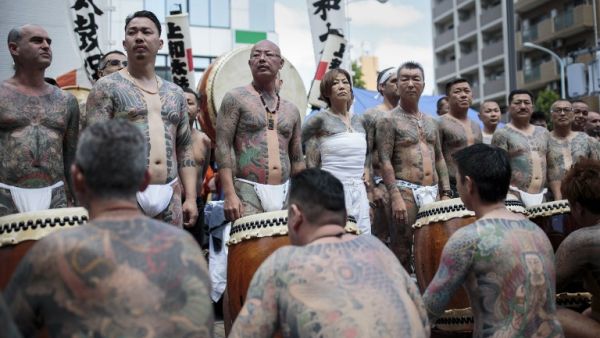Throngs of Japanese men and women have taken to the streets in their underwear to show off their full-body, Yakuza-style tattoos at one of Tokyo's most popular festivals.
The Sanja Matsuri festival, in the north Tokyo suburb of Asakusa, sees close to two million people taking to the streets in an annual celebration of the founders of the local Sensoji temple.
Each year, a parade of parishioners carries portable shrines or 'mikoshi' through the neighbourhood for the three-day-event, which dates back to the Edo period.
Despite being one of the city's more traditional festivals, Sanja Matsuri has a reputation for rowdiness and provides a rare chance for otherwise disparate sections of society to mingle and interact.
Among them are legions of stoic men and women sporting dazzling tattoos that are often associated with the Yakuza, Japan's notorious organised crime syndicate.
The Yakuza's ornamental tattoos often cover the entire body from the wrists to the ankles and up to the collar, where they abruptly stop - allowing the gang members to conceal the elaborate designs beneath their clothing.
There was no such discretion in play at Sanja Matsuri, as the men walked the wide open streets in little more than sumo underwear and sandals.
Many had stripes of untouched skin running down the middle of their torso, thus allowing them to unbutton their shirts in day-to-day life without giving away the tattoos - or any criminal implications that might be associated with them.
Heavily tattooed women, too, took to the streets in their undergarments to put their body art on full show.
Being tattooed is considered a rite of passage for the Yakuza, with images of samurais, dragons and koi fish among some of the more popular designs.
Yakuza-style tattoos do not typically curry favour in most tiers of Japanese society, however, with many public baths or 'onsens' banning tattoos altogether in an attempt to dissuade gang members from attending.
The Sanja Matsuri festival and parade, which takes place on the third weekend of May every year, is intended to bring luck, blessings and prosperity to the area of Asakusa and its inhabitants.
This article has been adapted from its original source.








